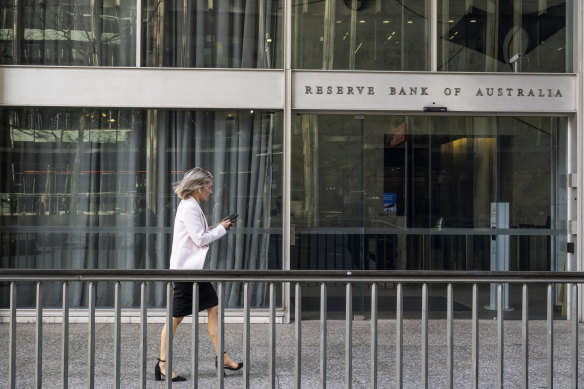Australia tipped to dodge recession even as China slows, US teeters
A key reason for the RBA’s less hawkish stance is a lower starting point for inflation compared with offshore counterparts. Consumer-price growth is also not expected to reach the alarming highs recorded in the US and elsewhere.
There is also little evidence of a wage-price spiral emerging, with pay rises remaining relatively moderate even as labour shortages worsen. Economists predict unemployment held at a 48-year low of 3.4 per cent in August ahead of jobs data out on Thursday.
Australia has also been a rare beneficiary of fallout from Russia’s invasion of Ukraine as disruptions to commodity and energy supplies have sent coal and other prices soaring. The nation posted a record-high monthly trade surplus this year, fuelled by sales of coal, iron ore and liquefied natural gas.

The Reserve Bank of Australia is in the midst of its sharpest tightening cycle in a generation.Credit:Louise Kennerley
“We have a tailwind from our terms of trade that other countries just don’t have,” said Alex Joiner, IFM Investors’ chief economist. “The export of LNG and coal have been extraordinarily beneficial. Our budget position will be in a much better position than many advanced economies.”
Unusually, the surge in export prices isn’t being reflected in Australia’s commodity-linked currency, which has averaged 69 US cents over the past three months. Commonwealth Bank sees the exchange rate dropping to 62 US cents by early next year, a level not seen since early 2020.
A lower currency swells profits from commodity exports priced in dollars and makes the country more appealing to overseas visitors and students.
Australia’s employment-to-population ratio is near a record high as is its participation rate – both much stronger than in many other countries – highlighting the underlying momentum in the labour market. Job vacancies also remain elevated, suggesting that strength will persist.
Loading
“It’s hard to see a sharp deterioration in the Australian economy when the labour market is so strong,” said ANZ Banking Group’s Catherine Birch, who expects unemployment to fall to 3 per cent by early 2023.
Australians still have plenty of savings to tap to support consumption, having built up a large amount of cash from fiscal stimulus delivered during COVID lockdowns when there were few options to spend.
Still it’s not all positive. A key area of concern is a rapid reversal in the property market, where prices are falling at a scale unseen since the eve of the 1991 recession.
The market hardest hit is bellwether Sydney, where home values have dropped almost 6 per cent in the past three months, compared with 3.4 per cent in the $9.9 trillion national market.
Further falls are inevitable as the RBA, which meets in just under three weeks, is expected to raise rates again. Australians are also heavily indebted, meaning higher borrowing costs will eventually begin to squeeze household budgets.
Bloomberg
For all the latest Business News Click Here
For the latest news and updates, follow us on Google News.
